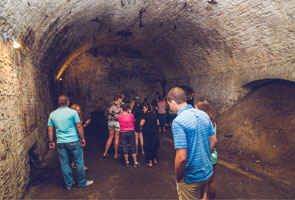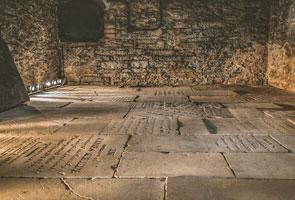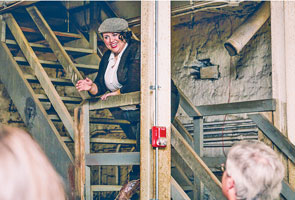Peter Bronson
 A crowd of suburbanites who are stretching the seams of their bicycle tights, yoga pants and loud golf shorts are spilling over the sidewalk, eyes popping as a guy who looks like Oscar the Grouch on meth walks by with a boom-box blasting obscene rap.
A crowd of suburbanites who are stretching the seams of their bicycle tights, yoga pants and loud golf shorts are spilling over the sidewalk, eyes popping as a guy who looks like Oscar the Grouch on meth walks by with a boom-box blasting obscene rap.
As the music fades, John Funcheon resumes his story and all eyes are on a dilapidated storefront across the street, painted in fading, sick-room green.
The World Series was born there in the bottom of a beer glass, Funcheon says. There is no marker or bronze plaque, but this is the historic beer garden where George “Boss” Cox ran Cincinnati from the 1880s to the early 1900s.
“This is where Boss Cox held court,” says the Queen City Underground tour guide, whose bushy Smith Bros. beard would look at home on a box of cherry cough drops or behind the bar at the Boss Cox saloon. “This is where the deals were done.”
And one of those deals involved August Herrmann, director of the city Water Works, president of the Cincinnati Reds and the unofficial commissioner of the major leagues in 1902. He was known as “the father of the World Series” for creating the first Major League Baseball playoff in 1903. But everyone knew Herrmann was a Cox-machine minion who didn’t get his mustache waxed without asking the Boss.
The tour moves on, sorting through boxes in Cincinnati’s dim, dank, dirt-floored basement. A stairway like  a mineshaft leads to a maze of beer-laagering tunnels hidden beneath the streets like the Catacombs of Rome. It’s a constant 58 degrees down there, perfect for beer, but not good for the workers who were sometimes overcome by carbon dioxide from fermentation.
a mineshaft leads to a maze of beer-laagering tunnels hidden beneath the streets like the Catacombs of Rome. It’s a constant 58 degrees down there, perfect for beer, but not good for the workers who were sometimes overcome by carbon dioxide from fermentation.
Another stop is down stone steps as worn as headstones, ending in a spider-webbed crypt under St. Francis Seraph Church, where early settlers are buried. Back on the street, Funcheon points out faded German street names that were erased during World War I, when being German was verboten. Then he launches into the story of the 2001 riots.
Trailed by his flock, he points and waves and greets everyone like the Mayor of OTR as he brings the past to life with CPR enthusiasm. But he’s not just telling the history. He’s selling the future. If he wasn’t paid to do this, he would probably do it for free, and crowds would gather just to hear him spread the good news about the resurrection of Over-the-Rhine.
It’s almost a miracle.
Just a few years ago, the same stretch of Vine north of Central Parkway was Zombietown, where drunks and drug addicts would float and stagger through traffic as drivers reached for the automatic door locks. Over-the-Rhine was the box where City Hall put all the broken toys: mental health, homeless shelters, prison halfway houses and alcohol and drug treatment.
 Those services are not gone. But now they’re neighbors to whole blocks of hip restaurants with names such as the Senate, the Eagle, Bakersfield and Pontiac Barbecue, where weekend crowds line up and wait for hours to eat fried chicken and drink craft beers. Most of the credit goes to 3CDC, the private, nonprofit development tool that has pumped $330 million into the neighborhood.
Those services are not gone. But now they’re neighbors to whole blocks of hip restaurants with names such as the Senate, the Eagle, Bakersfield and Pontiac Barbecue, where weekend crowds line up and wait for hours to eat fried chicken and drink craft beers. Most of the credit goes to 3CDC, the private, nonprofit development tool that has pumped $330 million into the neighborhood.
“There’s a real change in enthusiasm,” says Funcheon, 27, who grew up in Anderson Township and has lived north of Liberty in OTR for five years. “There’s a constant conversation going on about the neighborhood. Crime is down. There are jobs. The parks are being improved.”
The biggest reaction he gets from tour groups is, “I had no idea.” As in “I had no idea OTR was safe and fun and so historic.”
The tour business is booming. American Legacy Tours runs four groups of 60 on Saturdays, two on Sundays, and added weekdays this year to keep up with demand. “When we first talked about touring Over-the-Rhine people thought we were crazy,” Funcheon says. Street people accused him of turning the neighborhood into “a zoo for white people.”
He doesn’t hear that anymore.
Dwight Plair, a merchant in the neighborhood for 20 years, says, “I welcome the tours. Over-the-Rhine had a bad reputation. I hope people get a different picture.”
Gwen Hill, who sells sunglasses and bottled water from a sidewalk card table, says, “It was time for a change. Those businesses have brightened up the community. They done pushed the crime out and that’s a good thing.”
Crime was not eradicated, they emphasize—only relocated to other neighborhoods.
That’s the ongoing discussion Funcheon describes. “There’s a real conversation here about race, economic status, religion. People get real about it. They embrace their differences of opinion,” he says. “And it’s vastly different from what you see in the media or social media. It’s frank and open. People are still healing from what happened here 14 years ago.”
He’s talking about the riots of 2001, when most of the coverage focused on Over-the-Rhine as ground zero for race riots that led to an epidemic of black-on-black shootings. Funcheon says his neighbors will not let it happen again. They were unjustly blamed for looting and rioting done by outsiders, he says. “They felt like hostages to criminals.”
Brother Tim Sucher of St. Frances Seraph calls the revival a positive “re-gentrification,” a return to the glory days when OTR was prosperous and healthy, with hundreds of saloons, breweries and theaters. But he adds, “People come and say ‘Look how you changed the neighborhood.’ No you didn’t. You just moved it.”
Some poor were displaced, but it was kept to a minimum compared to other cities because the nonprofits led the way. And nearly everyone—street vendors, weekend crowds, business owners, residents—welcomes the new and improved Cincinnati Police presence.
Funcheon’s example is a fight that broke out near his tour group one Saturday morning. He went to break it up, and when the police arrived they calmed everyone down and immediately said, “Nobody is getting arrested. We’re going to work this out.”
The tour group “was freaked out,” he says. “But they were ignoring it, nobody said anything.” Which may be a metaphor for the way suburban Cincinnati sees Over-the-Rhine—ignore it, don’t say anything. That’s natural to avoid conflict. But conflict leads to positive change, Funcheon says.
“I think this is the most important neighborhood in the country right now, because we have made the tough changes that Ferguson and Baltimore are just addressing now. We did it 14 years ago. We talk about it all the time. The attitude here is no way, not again. That will not happen again.”
Brother Tim points out that what visitors see is just a beachhead. North of the Vine Street Kroger, the old OTR looks mostly untouched by the magic wand of the 3CDC Fairy Godmother.
But there’s hope.
Funcheon tells me about a couple that came from Washington, D.C. to take a tour and loved it so much they moved to OTR. “That’s why I do what I do,” he says. “I fell in love with the neighborhood myself. I feel very much at home here. If you treat people the way you want to be treated, it’s a very friendly place.”
There’s a lot to see. OTR is famous for the largest intact collection of historic 19th Century Italianate architecture in the U.S. The beer garden where Boss Cox ruled is still there because Cincinnati abandoned the whole neighborhood—a curse that became a blessing in a time capsule.
“Over-the-Rhine has come a long way,” says Joseph, a Vine Street business owner who did not want to give his last name. “There used to be gunshots everywhere. I saw a couple of people shot right in front of me. But now it’s a beautiful community. I see people out at night now, riding their bikes, walking around, holding hands. Completely different.”
The tour ends, appropriately, at the Moerlein Brewing Company, where tourists sample craft brews such as “Fifth & Vine” and “OTR” that toast the glory days when Cincinnati drank more suds than St. Louis and Milwaukee, and Boss Cox ruled the World Series.
Over-the-Rhine has never looked better through the bottom of a beer glass.
